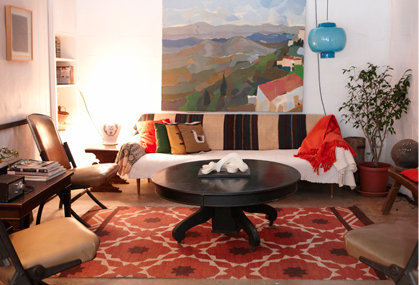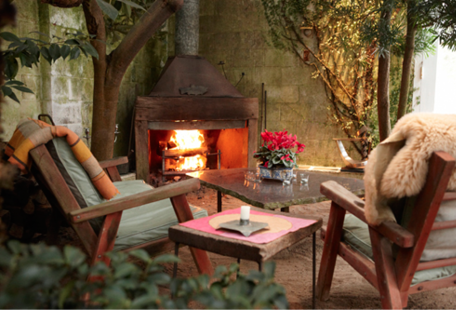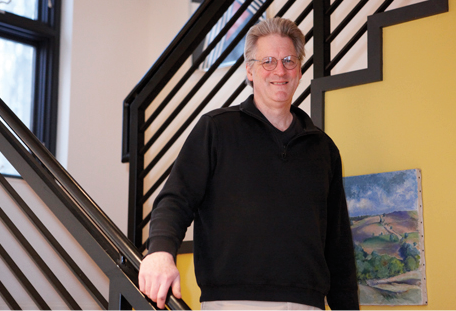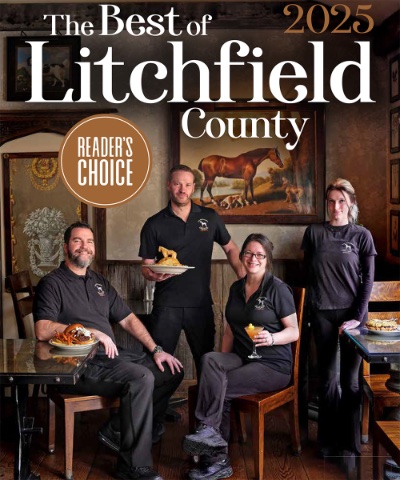February 1, 2014
With generations of artists and community thinkers
before them, Barbara and Peter Talbot carry on the legacy,
with a keen eye on what comes next.
Architect Peter Talbot and his wife, singer-songwriter and arts professional Barbara Hyde Talbot, are in the entryway of Bell Hill House, in Washington, and Peter is pointing out a collapsible copper lantern, lit by a candle and covered in cotton fabric, that was given to him on a recent trip to Kenya. “Isn’t this a cool candle?” Peter asks. And, yes, it is a cool candle, but like most of the art, objects, and even exotic plants in Bell Hill House (family home to generations of artistic Talbots), it’s the story behind it that’s as interesting as the object itself. Take the lantern: Peter Talbot was in Kenya as a consulting architect with The Cornerstone Project, a nonprofit that provides education for children orphaned by AIDS, and which is currently building the Nambale Magnet School to serve 200 kids. “We’re trying to make the school environmentally and economically sound. One of the ways is by designing septic systems—biodigesters—that can turn the resulting methane gas into fuel for cooking. No firewood needed.”

Here in the Litchfield Hills, though, on a subzero January day, wood fires crackle in Bell Hill House’s living room and in the lush greenhouse, where, among the tropical plants, grapefruit dangle from a tree that Peter’s father, sculptor William H. M. Talbot, planted from the seeds of his breakfast grapefruit back in the 1940s. From the blooming camellia trees, Peter snips a delicate flower each week to bring to the office (“just like Coco Chanel, who had camellias delivered to her office every day”). William and his wife, Joan Sangree Talbot, a photographer and musician who played the viola da gamba in an early-music ensemble and was a singer in the St. John’s Chorale, had lovingly built the greenhouse from scratch, when they converted the former horse barn into a home for themselves and their four children in 1952. Joan, who for decades invited fellow gardeners to join her in her green spaces, continued to climb out on a catwalk suspended from the ceiling of the greenhouse to prune the trees into her eighties, much to her son and daughter-in-law’s chagrin.



“When I came to this house for the first time, in 1984,” says the Canadian-born Barbara, referring to the first visit she made to Bell Hill from New York City with a friend, “it was like I’d stepped back in time 20 years. I was smitten.” The 1950s and 60s had, in fact, been a sort of heyday for the house, when William Talbot, the Prix de Rome winner whose work was collected by the likes of the Whitney Museum, would fire up his arc welder and light up the night sky from his upstairs studio as he sculpted pieces like the enormous 12-foot concrete, stained-glass, and steel tower with built-in flashing lights and a kind of Afro-pop soundtrack that still stands tall in the studio today. “Then, of course, I met Peter,” she says, “and I was smitten again.”



We always had a houseful,” says Peter. And Bell Hill House, having once been a working barn, with bedrooms William and Joan created from former horse stalls, supplied plenty of room. There were William’s interns, of course. But his parents also put on French Film Nights, Peter says, when artists and writers from the surrounding area would drop by to watch, say, a Godard picture projected on the wall, or the senior Talbots would erect a Bedoin-style tent in the studio and throw a dinner party for their friends.
Some of those friends might include artists Yves Tanguy; Alexander Calder and his wife, Louisa, who had a place in Roxbury; or inventor Buckminster Fuller (who had been at Harvard with Peter’s grandfather). And then there were literary lions like Norman Mailer, Arthur Miller, and Bill Styron. The community drew some of the best and the brightest, and made Washington’s reputation as their retreat from the world.

The free spirit of Bell Hill House—where Joan’s fellow musicians would gather to play, and where wildlife-lover William rescued owls that he then let fly among the trees in the greenhouse—lives on with Peter and Barbara. At Bell Hill, where Peter himself once had his architecture office, the couple have hosted a houseful of Momix dancers, and a regular gathering of the Wykeham Consort, as well as plein air painters, and families who simply are in need of some good old Litchfield Hills country air (the Talbots rent the house through vrbo.com, homeaway.com, and boutique-homes.com).

But that spirit is more than simply gathering friends and keeping the family home alive and thriving. (Peter and Barbara live not far away on the rambling property, in a light-filled, modern masterpiece of understatement that Peter designed and that includes a ceiling designed with fiber optics to re-create the night sky and a wall inspired by the harp of a piano, a nod to pianist Barbara. In turn, Barbara’s handmade Scandinavian-inspired pendant lamps, and her amorphous multimedia installations that use moving images, acetate, and the flow of water, seem constructed with a great sense of play.) The spirit passed on by the senior Talbots to the following generations is one of community, of building something that respects the past while gracefully advancing toward the future.

Peter (who once chaired the Building Commission) is now vice president and Barbara chair of the nominating committee of the Washington Arts Association (WAA), which was launched in 1952, with William Talbot and Joan Sangree as two of the founding members. In a photo of the WAA founders from the early days, standing behind the mostly elderly blue-haired members is Peter’s dad, in his early thirties, all six-foot-six and 240 pounds of him. Joan was part of the WAA administration for 40 years, as secretary and member of the board of directors. “The association is having a renaissance,” says Barbara, who is committed to the educational programs the association is growing. “Membership is way up, and we’re getting a lot of younger members. We’re developing a youth program, which is vital. And the trustees are new and energetic.” One of the projects underway, she says, is a cookbook, edited by designer Linda Allard and Susan Purdy (author of Perfect Pie and Let Them Eat Cake) to which 93 WAA members have contributed their favorite recipes and original artwork.


Public design has always been a part of Peter Talbot’s environmentally sustainable practice, since his days with Manhattan firm Polshek Partners. It includes not only a school half a world away but the restaurant Community Table, just down the road, with its shades of Scandinavia and its New England warmth. Now there’s a community project that lights up the couple’s eyes—One Green Hill Circle, in the heart of the Depot. Peter, who also spent 17 years on the Washington Historic District Commission, and whose architecture practice, Peter Talbot Architects, has a home in the village’s rejuvenated Woodruff’s Garage, set his sites, and those of fellow preservation-minded locals to purchase, rehab, and repurpose the long-vacant Texaco station just a stone’s throw from the town hall. The newly formed nonprofit Washington Park Foundation envisions, says Peter, “a flexible space for community gatherings, art and school exhibits, information on the area, and opportunities for indie entrepreneurs and small businesses to sell their products (plants and flowers, food, jewelry, art and more) as well as programs from nonprofits such as the Institute for American Indian Studies. And the foundation hopes to build a pocket park for people to enjoy.” (You can find out more at washingtonparkfoundation.org, a website that Barbara designed for the group.) So far, the foundation [other members include Michael Ackerman, Barbara Boyea, John Millington, and Denise Trevenen] has purchased the building, but no definitive plan has been approved by the town to move forward. “I don’t think there’s a precedent in Washington for what we’re doing here,” Peter says. “But people across the country are thinking about how you protect open space and at the same time not minimize or diminish the ability for people to live and have a viable life.

In pursuit of learning more about what inventive architects and planners across the country are thinking, Peter recently completed a master’s course with the Regenesis Group, a New Mexico–based organization that promotes sustainable development with a deep understanding of a site’s history. “It’s difficult to articulate the idea of regenesis,” Peter says, “but when there’s a history behind a place and there are natural forces acting on it, you combine them to come up with a rational way of proceeding that helps the greater whole. Rather than looking at a project as something unto itself, it means looking at it as part of a system.”

This past September, the show “Just Talbots: Three Generations of Artistic Achievement,” at Washington’s Behnke-Doherty Gallery, featured the work of William H.M. Talbot (sculpture), Joan Sangree (photographs), Peter (architectural models), Barbara, and their son, Will (both mixed media), as well as Peter’s siblings Augusta (painting and sculpture), Connie (ceramics), and John (wood sculpture). The thread that runs through them might not be immediately evident, but a closer look creates an incredibly diverse portrait of a family. And, as the Talbots have done for generations, that thread will be woven into lives that go far beyond the family tree.



















